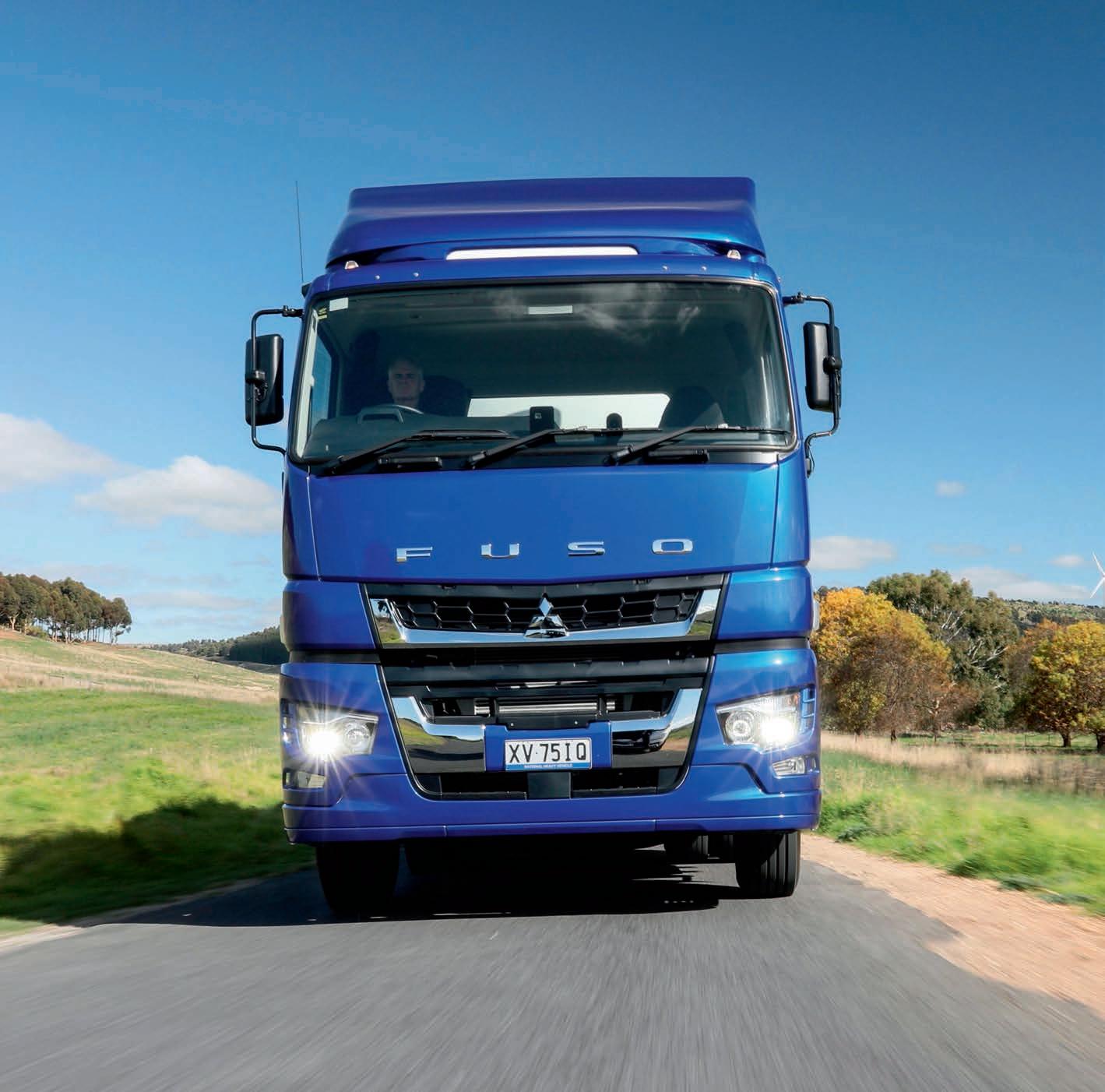
16 minute read
SHOGUN SHAPES UP
While there’s no doubting the domination of Japanese trucks in rigid classes, the prime mover business has been historically a hit and miss affair for Tokyo toilers. There is, however, change in the air as global giants fashion a stronger future based on ‘family’ powertrains and advanced safety systems. But as Fuso’s new Shogun shows, there are limits on how much muscle corporate masters are prepared to give their Japanese comrades. Steve Brooks reports
AS FAR as prime movers go, Japanese trucks generally don’t rate high on the heap. At least, not in this country and certainly not on linehaul routes.
Sure, there are exceptions. Some operators swear by their positive experience with a particular brand of Japanese prime mover but with even fewer exceptions, it’s an experience largely limited to metro work or relatively short regional runs.
Funny thing though, over the ditch in Kiwi country, Japanese models are a major player in every part of the prime mover market. Horses for courses, I guess, given that distances and conditions in the two countries are as blatantly different as ‘six’ and ‘sux’.
Whatever, it’s been many years since a Japanese brand had a notable presence in the ranks of Australian prime movers. Decades in fact, way back to the days when basic workhorses like UD’s singledrive CK40 and later, the tandem-drive CWA45, demonstrated Japan’s ability to offset modest muscle with trucks at least built to endure considerable hardship.
Nonetheless, it’s generally a lonely story for Japanese prime movers in our neck of the woods for the simple reason that unlike their American and European counterparts, truck and trailer
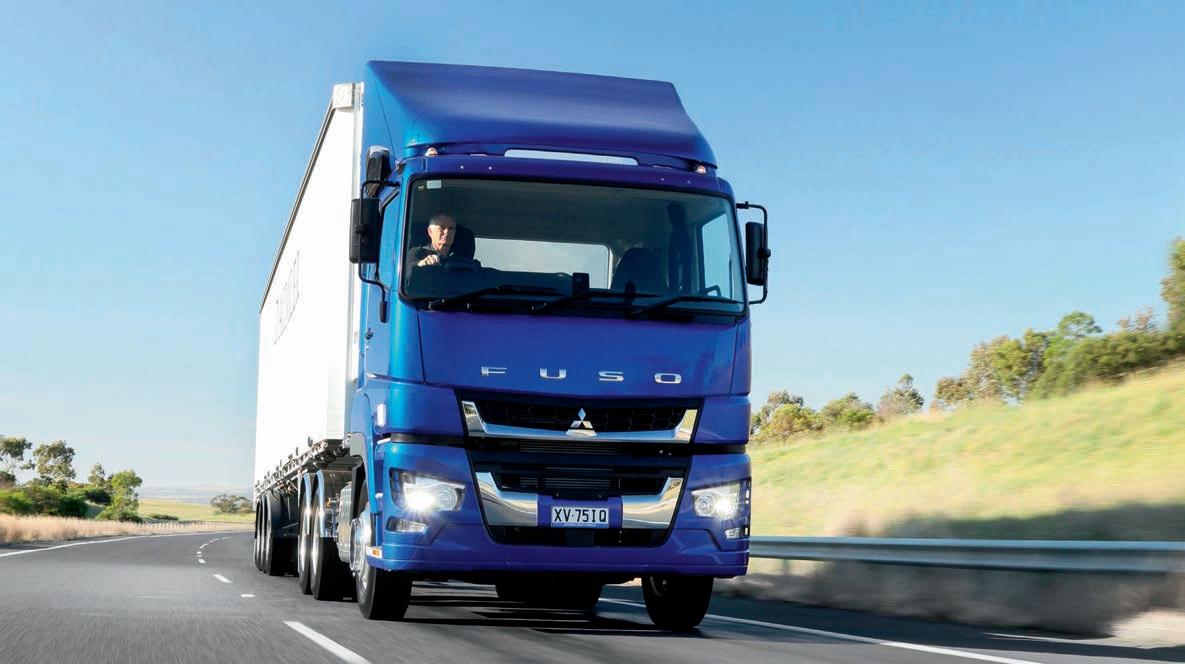
combinations are the exception rather than the rule in both the Japanese domestic market and the majority of Japan’s Asian export markets. Or put another way, Japan’s historic needs for a potently powered and generously appointed prime mover are significantly less than those common to Europe or North America.
However, times are changing. Big time! For starters, brands like Fuso and UD are no longer the masters of their own destiny and accordingly, with European giants calling the shots, there’s now a distinct effort to develop models for a wider range of heavy-duty roles. Notably, as prime movers in markets such as ours.
UD, of course, is part of Volvo Group but that, too, is about to change following the startling announcement last year of a deal between Isuzu and the Swedish giant which among other things proposes the transfer of UD ownership to its Japanese compatriot. Moreover, if the deal goes ahead as indicated, it will be particularly fascinating to watch how the future of UD’s impressive Quon model unfolds on the Australian market as Isuzu strives to further increase its presence in the heavy-duty sector, especially in prime mover roles.
For example, as the owner of UD, will Isuzu Australia use Quon as a platform to bolster its openly stated goal of a higher stake in the prime mover business? Or, will it continue to lay its hopes on the arrival of Japan’s advanced new Giga model punched by a 500-plus 12- or 13-litre Cummins derived from Isuzu’s ‘technical relationship’ with the specialist engine maker? Right now, an answer continues to drift in the corporate clouds.
Fuso, on the other hand, is an entirely entrenched part of the vast Daimler Trucks empire with next to no likelihood of ever being anything less than a vital, high volume partner in the Daimler portfolio, alongside Freightliner and Mercedes-Benz. Indeed, it is abundantly clear that Daimler’s long-term aspirations for Fuso have always been far more enterprising and expansive than anything Volvo could have hoped to achieve with UD.
Yet, one thing the two giants of the commercial vehicle world currently have in common is the determination to keep their Japanese flagships within strictly controlled performance parameters. For instance, just as Volvo limits UD’s Quon to the 460hp (343kW) peak of the group’s 11-litre engine, steadfastly refusing to allow the installation of the 500-plus 13-litre engine used in Volvo and Mack models, so does Daimler appear entirely determined to limit the new Shogun to the 455hp (339kW) peak of the 10.7-litre ‘family’ engine known as the OM470. In effect, there is no intention of Daimler adding the 12.8-litre OM471 engine – the same engine which powers Mercedes-Benz’s prominent 2651 and 2653 models at around 510 and 530hp (380 and 395kW) respectively – to Shogun’s armoury.
The reasons for such performance constraints aren’t difficult to understand. One is that Japan has next to no need for a truck of 500hp (373kW) or more, meaning the economic viability of engineering the 12.8-litre engine into Fuso’s flagship for relatively small volume markets such as Australia
and New Zealand is not especially attractive.
The bigger reason, however, is probably found in the closely guarded corporate rationale which strives to restrict brands from the same stable going head-to-head in commercial contest. Put simply, Daimler will keep Fuso’s heavy-duty range hobbled to specific performance peaks where opportunities for a competitive clash with the Benz breed are kept to an absolute minimum.
As we’ve stated before, neither Volvo nor Daimler have ever been big on the idea of turning their Japanese offshoots into budgetpriced alternatives to their premier heavy-duty brands.
Consequently, with peak power of 455hp (336kW) at 1,600rpm and top torque of 2,200Nm (1,622ft-lb) at 1,100rpm – outputs which, incidentally, are largely identical to the superseded 12-litre engine in Fuso’s previous heavy-duty line-up – Shogun is unequivocally destined to follow in the footsteps of its predecessors as a heavyduty truck aimed at metro and shorthaul regional work rather than as a quasi-linehauler.
Above: Finer Fuso: It’s not a linehaul contender but the new Fuso FV-R is certainly a better prime mover proposition for metro work and shorthaul country runs
Below: The rocker cover says ‘Fuso’ but make no mistake, the 10.7-litre OM470 engine is straight from the Daimler family powerhouse
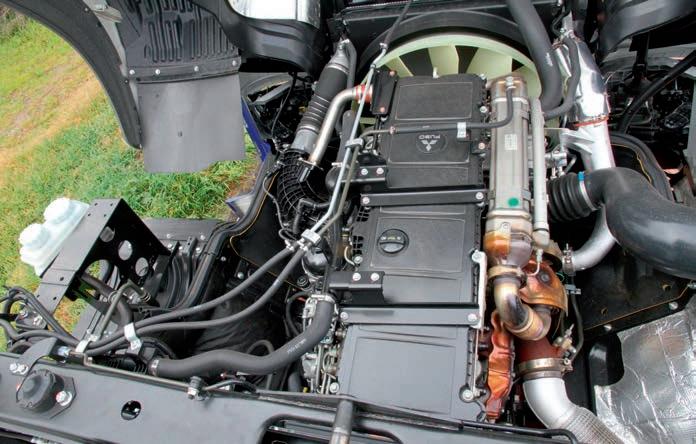
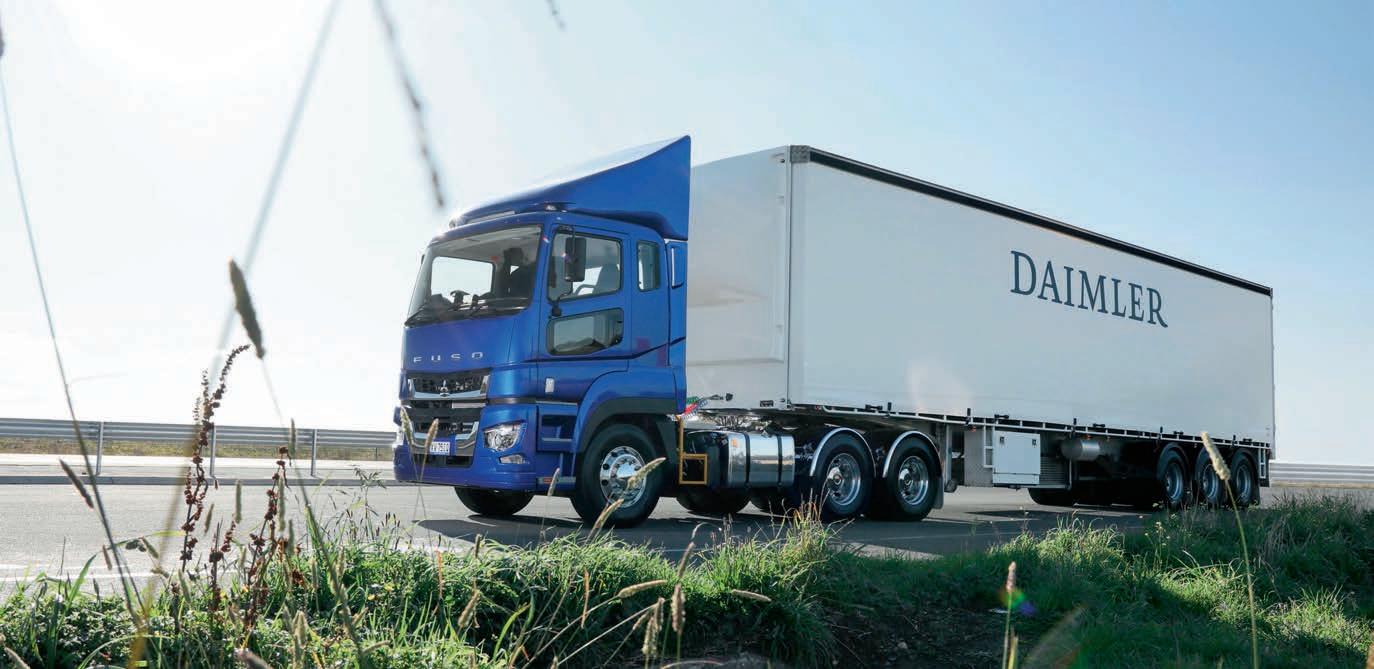
That said though, a full day behind the wheel of a near-new Shogun six-wheeler hauling a loaded tri-axle trailer revealed a model massively better equipped than its forebear to tackle truck and trailer work due entirely to the installation of the advanced technology, qualities and features of the world’s largest and most successful commercial vehicle producer.
Yet, like the superseded range, Shogun covers plenty of operational possibilities. For starters, there are two 6x4 versions – the FV rated to a gross combination mass limit (GCM) of 53 tonnes ostensibly for rigid truck and dog trailer duties and the dedicated FV-R prime mover, rated to 63 tonnes on a 3.91 metre wheelbase. What’s more, the FV-R offers a cab in flat roof and hi-roof form.
Also in the Shogun sheath is the FS eight-wheeler with its loadsharing front suspension and like the FVs, limited slip diffs in both drive axles as well as a 53 tonne GCM limit. Rounding off the range is the FP-R 4x2, a specialist single-drive prime mover built on a 3.8 metre wheelbase and carrying a GCM of 40 tonnes.
Whereas the two FV-R prime mover models run only the OM470 engine’s 455hp rating, for all other models in the range there’s also a 394hp (290kW) version with 2,000Nm (1,475ft-lb) of torque. In fact, in the single-drive FP-R, the lower rating is the only rating.
While the OM470’s outputs in both ratings are almost identical to those of the previous power plant, peak power is now delivered 300rpm lower and importantly, this latest ‘family’ engine is significantly more responsive. It is effectively the same engine used in Mercedes-Benz 2643 and 2646 models (430 and 455hp respectively), with common rail fuel injection, double overhead camshafts, Euro 6 emissions compliance and as our test run would reveal, a drivetrain designed to extract maximum effort from minimum fuel.
Above: As a dedicated prime mover spec, Fuso FV-R cab is available in flat roof and hi-roof forms. Observation glass in passenger side door goes some way to deleting a notorious blind spot
Right & below: Inside view. The family resemblance in switchgear and control layouts with MercedesBenz and now Freightliner is obvious, but better mirrors and higher quality driver’s seat wouldn’t go astray
Testing times
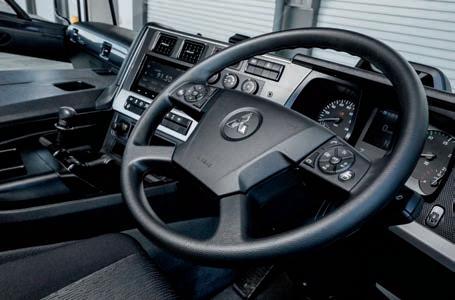
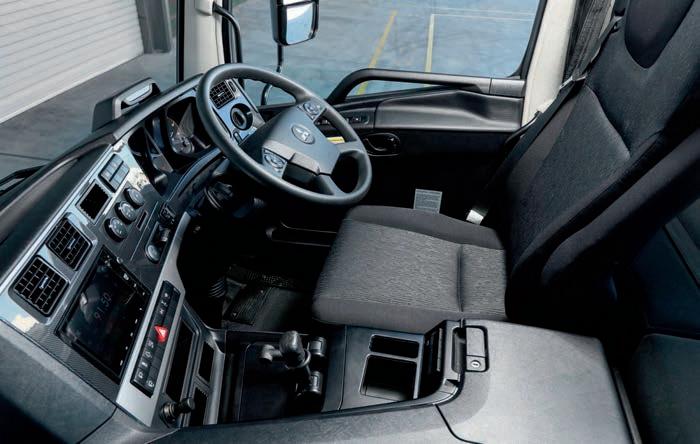
A day-long test drive of barely more than 300km at a gross weight of 40 tonnes from Daimler’s Huntingwood dealership in Sydney’s far west, down the Hume Freeway to Marulan and returning the same way except for a 50km deviation along the ‘old Hume’, may not seem a particularly tough test. In this instance, however, it revealed plenty on a route which not only reflects Shogun’s likely workloads, but also reinforced the findings of a run in a trial unit more than a year ago.
That earlier drive from Albury to Melbourne was, in fact, one of the final stages of an extensive Shogun test program preceding the model’s local launch, starting at Fuso’s Kitsuregawa proving ground in Japan before moving to trials on various Australian routes and a high-profile appearance at last year’s Brisbane Truck Show.
What’s more, the findings of that earlier report are equally relevant now. Like, “… the move to bring Fuso further into Daimler’s corporate mould with the introduction of the OM470 engine coupled to the DT12 automated overdrive transmission, all tucked under a significantly upgraded cab, will do the Japanese brand’s heavy-duty hopes no harm. No harm at all.
“Structurally, the cab shell is largely unchanged but a redesigned grille and front panel at least provide a more modern and less chunky appearance than the current crop of Fuso heavies; an appearance further enhanced by an entirely new group of LED headlamps.
“Importantly, especially for shorthaul distribution applications where drivers are constantly climbing in and out, the step entry level is markedly lower than current models.” It’s worth noting, however, that the air suspended cab stands surprisingly tall.
“Yet, from a driver’s perspective, the most appreciable advances are on the inside and again, the family resemblance to the latest Mercedes-Benz (and now Freightliner Cascadia) models is apparent in many details. And that, of course, can only be a good thing given the extraordinary acceptance of the new Benz breed.
“Similarly, the switchgear, control layout and information systems which we’ve applauded in numerous test drives of various MercedesBenz models over the past few years, particularly for their simpler logic and easier operation compared to European rivals, are entirely evident in the refreshed Fuso.
“The steering wheel, for instance, is straight from the ‘Book of Benz’ with easily understood control buttons for features such as

Above: Comprehensive multimedia package is a significant attribute which can accommodate up to five cameras
Opposite, above: Electronic cab tilt provides good engine access while non-slip step and access platform enhance safe trailer hook-ups the vehicle information system and cruise control mounted on the upper arms of the wheel.
“Also, like its Benz brothers, the transmission and engine brake are controlled through a wand on the steering column while on the other side of the column there’s a similar wand for indicators, high beam and the like. Either way, the wands provide fingertip control.”
Still on the inside, “… the relatively large expanse between driver and passenger seats is a convoluted collection of cavities and storage bins.
“It is, however, a big stretch to call the area behind the seats a sleeper section even if it does comply with the questionable regulatory dimensions that define an ‘approved’ sleeper berth.
“Even so, the new interior layout is streets ahead of Fuso’s earlier offering and from the driver’s seat, the only conclusion is that it’s simply a better place to work.”
It is also a far safer place to work despite the surprise and disappointment of Fuso’s decision to continue with its existing wedge drum brakes rather than the disc brakes which are, of course, the norm on Mercedes-Benz models. But then, at least the brakes on the new range operate on an EBS (electronic) platform rather than the previous pneumatic control system.
What’s more, as we reported last year, “the electronic architecture of the new models allows Fuso to incorporate the same advanced safety systems as those fitted to Mercedes-Benz including an electronic stability program, active emergency braking, lane departure warning system, active cruise control and a hill-hold function”.
“Furthermore, Fuso’s version of the 10.7 litre engine uses a combination of SCR and EGR technology along with a diesel particulate filter to meet Japan’s latest emissions requirement which is said to be even more stringent than the Euro 6 standard.”
Inside and out, it’s simply a much better truck.
Road run
Just as the Fuso’s engine is from Daimler’s ‘group’ inventory so, too, is the 12-speed overdrive automated transmission and together, the two work in absolute harmony.
With less than 3,000km on the dial at the start of the run, hauling a new Vawdrey curtain-sided trailer, first through the congested arteries of western Sydney and then the Hume’s undulating freeway down to Marulan and back, the powertrain’s compatibility and intuitive aptitude for delivering exactly the right shift at exactly the right time were remarkable and at least the equal of the best in the market. Top marks!
In performance terms, the best indicators of the Fuso’s lively response and surprisingly strong tenacity came on the southbound stretch up ‘Skyline’ on the Hume Freeway and a little further on, the climb out of the Mittagong dip. On both climbs, the combination settled back to 10th gear with engine revs dropping no lower than 1,500rpm.
Meanwhile, on downhill runs, the three-stage retardation system was reasonably effective in most conditions and certainly an asset when operating in concert with cruise control. Actually, it’s a surprisingly effective retarder given the engine’s relatively modest displacement.
It was, however, on the open stretches of the Hume that the FV-R prime mover further indicated why its true vocation is as a metro
FIX BLOWBY AND AVOID THE REBUILD.

Proudly 100% Australian Made and Owned

#1 BLOWBY?
Most blowby can be easily fixed… even at 1.5 to 2 million kms. Sticking piston rings are the main culprit.
“This fixed my Series 60. It was fuming badly, using 6-7L of oil every 2 days.” – Merv Sweetman.
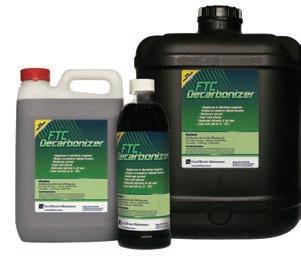
PHONE (07) 3376 6188 #2 ENGINE SLUDGE
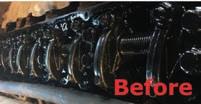

Sludge prevents good lubrication, lowers oil pressure, causes overheating and valve noises!
Get pristine clean again…FAST & EASY!
#3 DIRTY ENGINE OIL?
It should never stain your hands. Even at oil change. If it does you will have engine sludge & power loss.
“My T650 Kenworth lost power, was smoking badly and using oil. Cummins said it needed a $32,000 rebuild! I tried FTC Decarbonizer and Flushing Oil Concentrate. I was absolutely amazed how much rubbish came out on the flush. Now the power’s great! No smoke! No oil use!” – Hugh Maslin
costeffective.com.au
2/18 Boron St, SUMNER PARK QLD 4074 E: sales@costeffective.com.au FREE DELIVERY AUSTRALIA WIDE
and shorthaul regional runner rather than a highway hauler. Riding on an airbag rear suspension, the drive tandem on the FV-R is only available with a 4.625:1 final drive ratio, which, even with the benefit of the automated transmission’s 0.775:1 overdrive top gear, notches 100km/h at a tall 1,800rpm. For linehaul work in this day and age, 100km/h is ordinarily achieved somewhere around 1,400 to 1,500rpm.
At 40 tonnes in metro areas though, it’s a powertrain which makes easy work of stuttering traffic flows, showing an equally easy ability to skip shift smoothly through the lower gears.
According to the truck’s on-board information, fuel economy after 312km of suburban shuffling, highway running and country backroads was 2.3km/litre, or 43.48 litres/100km, or for us more mature folk, 6.5mpg. Overall, it’s a highly respectable return for a near-new truck operating in a wide range of conditions and traffic densities.
However, steering quality also points to a truck more suited to local work than linehaul. At speeds approaching 100km/h, and taking into account the fact that the test truck’s load distribution put little more than five tonnes over the front axle, steering response was generally too reactive on highway stretches. Twitchy even, causing a consistent effort at the steering wheel to keep the truck on a desired line. But then, in relatively slow work through the ‘burbs, steering is effortlessly light and combined with a sharp turning circle, provides excellent manoeuvrability.
Still, while the inclusion of so many advanced attributes makes Shogun a vastly better truck than its predecessor, and certainly a prime contender for many forms of prime mover work, there’s ample room for further improvement.
Like, rear view mirrors are a significant disappointment. Sure, they’re heated and electrically controlled, but the main glass area is simply not deep enough. Even the single mounting arms appear questionable for long-term durability.
On the positive side though, a sizeable glass section in the lower half of the passenger door is a definite advantage in tight traffic, particularly for sighting marauding motorbikes and suicidal cyclists.
Back on the inside, the driver’s seat isn’t particularly praiseworthy either, causing a numb bum after just a few hours at the wheel. The truck deserves better. So do its drivers.
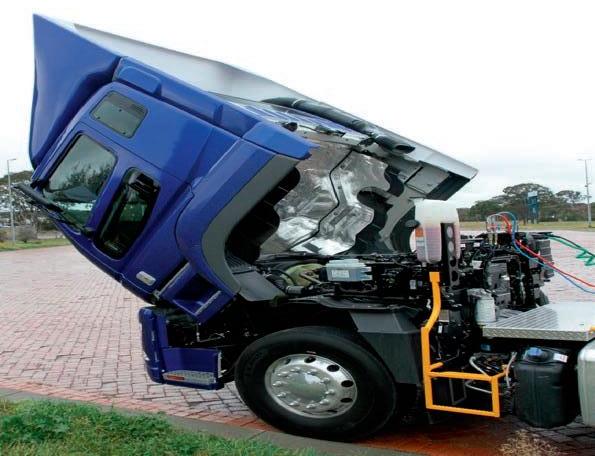
Yet even with these complaints, it’s worth emphasising again that Shogun represents a huge step on Fuso’s evolutionary path.
Sure, it’s still a Japanese truck in many areas with an internal layout that maintains its historical links to Asian requirements rather than our own, but the Daimler influence is apparent in almost every operational aspect, from safety to emissions, efficiency, performance and not least, the general standard of build quality.
No question, Daimler has indeed delivered a finer Fuso.
Specifications
Make/Model: Fuso FV-R prime mover Wheelbase: 3,910mm Engine: 10.7 litre OM470 six cylinder. 335kW (455hp) at 1,600rpm, 2,200Nm (1,622ft-lb) at 1,100rpm. Euro 6 emissions Transmission: 12-speed overdrive automated manual with crawler mode, eco-roll mode, torque limited for 1st and reverse Fuel capacity: 400 litres Suspension: Front – taper leaf; rear – air suspension Weights: GVM 24 tonnes. GCM 63 tonnes
INNOVATIVE TARPING SOLUTIONS FOR EVERY NEED Cover your load!
Australian Distributors of
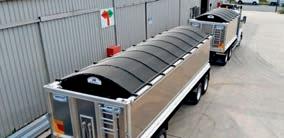

Wind-out Hood Tarps Dual Arm Systems

Long Block Waterproof tarps Roll-Rite Gearmotors Single Arm Systems
Tarping system components & solutions
• Dual Cable Wind-out Tarps • Pivot Arm Systems • Electric Gear Drive Motors • Single Cable Wind-out Tarps • Electronic Controllers • Waste Tarps • Pull-out Tarps • Waterproof Systems • Roll-over Tarps • Asphalt Tarps
NEW HEAVY-DUTY GEARBOXES

New Heavy-Duty Gearboxes designed for the Aussie Market Updated high strength composite casing Up to 180 Nm of torque, keeping operation smooth and your tarp tight Easy to install and operate with Retractable Tarp’s one touch tarp controllers. Hardwired and wireless control options available Get yourself covered today! OUT NOW!
OWD-QV-5188294-TS-323
Check out our innovative solutions to help cover your load!

Visit www.retractabletarps.com.au or call 07 3889 9611 today!





